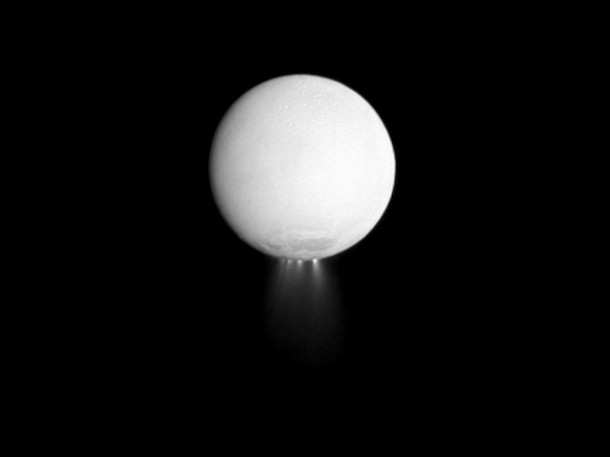We're open daily! View holiday hours
Science News
Enceladus Solves Mystery
July 27, 2011

For fourteen years, scientists have wondered where the water in Saturn’s upper atmosphere comes from. Now, European scientists, using ESA’s Herschel Space Observatory, have solved the mystery.
As the astronomers report in the August issue of Astronomy & Astrophysics, Saturn’s “rain” is coming from its moon, Enceladus.
Enceladus expels around 250 kilograms (or 550 pounds) of water vapor every second, through a collection of jets in its south polar region. (That’s equivalent to the water in the Academy’s coral reef tank every hour!) Most of the water is lost in space, but some of it reaches Saturn’s E ring, and some of it, as now discovered, creates a transparent “belt” around the ringed planet. The belt, known as a torus to sciencey-folks, extends out to a distance more than ten times the radius of Saturn, yet with a thickness of only about one Saturn radius. Enceladus orbits the planet at a distance of about four Saturn radii, replenishing the torus with geysers of water.
Despite its enormous size, the torus has escaped detection until now because water vapor is transparent to visible light. Herschel was designed to see infrared wavelengths, which managed to detect the diffuse ring of water.
Computer models of these latest Herschel observations suggest that about 3-5% of the water expelled by Enceladus ends up falling into Saturn.
Phil Plait, the Bad Astronomer, puts this into perspective in his blog on Discover:
In a heavy rainstorm on Earth, you get about 1 inch of water an hour falling down. That’s .0007 grams/second falling on a square centimeter of ground, so the rain on Earth is roughly 42 trillion times heavier than on Saturn. I don’t think you’ll need an umbrella if you visit.
But it’s the source of the water that’s making such a splash. “There is no analogy to this behavior on Earth,” says Paul Hartogh of the Max Planck Institute for Solar System Research, who led the collaboration on the analysis of these results. “No significant quantities of water enter our atmosphere from space. This is unique to Saturn.”
What will the astronomers have to wonder about now? Don’t worry, there’s always something, reports Scientific American:
Interestingly, Enceladus seems not to be the source of water vapor detected on Titan, Saturn’s largest moon. Hartogh and his co-authors calculate that Enceladus's geysers provide far too little water vapor to account for the observations of Titan. For now, they wrote, “the origin of Titan’s water remains a puzzle.”
Good luck with that one, astrofolks!
Iamge: NASA/JPL/Space Science Institute